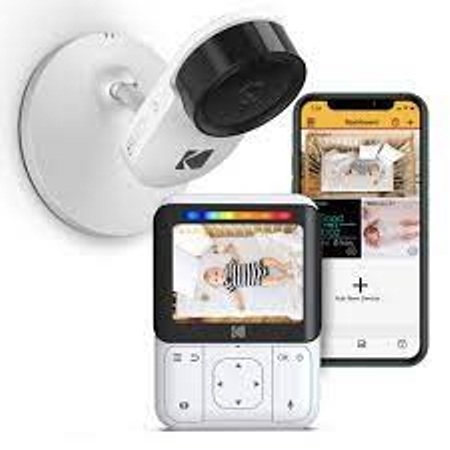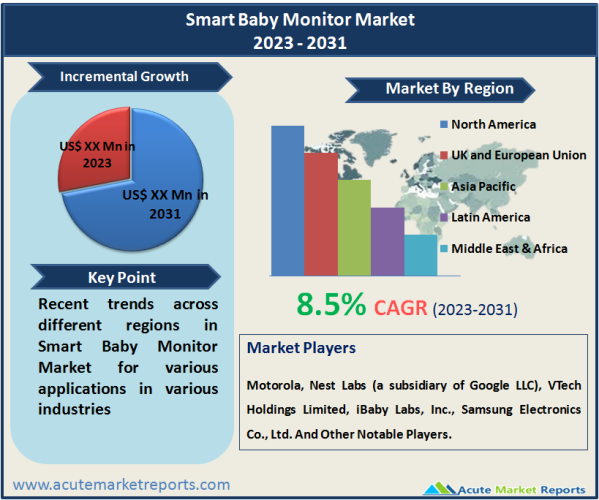
The smart baby monitor market is expected to grow at a CAGR of 8.5% during the forecast period of 2025 to 2033, driven by several key factors. In this comprehensive overview, we will delve into three drivers that have played a crucial role in propelling the market forward, as well as one major restraint that has challenged its growth. The smart baby monitor market has been driven by technological advancements, increasing awareness of infant safety, and urbanization. However, privacy and security concerns have acted as a significant restraint. Additionally, competitive trends indicate the dominance of key players and their strategies to maintain a competitive edge. As the market moves into the forecast period from 2025 to 2033, the smart baby monitor industry is expected to continue its upward trajectory, driven by innovation, consumer demand, and a growing emphasis on child safety and convenience.

Advancements in Technology and IoT Integration
Advancements in technology, especially in the Internet of Things (IoT) domain, have been a major driver for the smart baby monitor market. With the integration of IoT in baby monitors, parents, and caregivers can remotely monitor their babies in real time through smartphones and tablets. These devices offer features such as video streaming, temperature monitoring, motion detection, and even two-way communication. Additionally, smart baby monitors equipped with artificial intelligence (AI) algorithms can provide valuable insights into a baby's sleep patterns and health, helping parents identify potential issues early on. Furthermore, the proliferation of home automation systems has facilitated the seamless integration of smart baby monitors with other smart devices, enhancing the overall user experience. The ease of use and convenience provided by these advanced features have significantly increased the demand for smart baby monitors, fostering market growth.
Growing Awareness about Infant Safety and Security
The growing awareness among parents and caregivers regarding infant safety and security has been another crucial driver for the smart baby monitor market. Traditional audio-only baby monitors offered limited functionality, leaving parents anxious about their babies' well-being. However, smart baby monitors equipped with video capabilities have addressed these concerns by providing a clear visual of the baby's sleeping environment. This visibility offers parents peace of mind and empowers them to respond promptly to any potential risks. Additionally, as parents seek to balance their personal and professional lives, the need for reliable and efficient childcare solutions has increased. Smart baby monitors cater to this demand, enabling parents to stay connected with their babies while attending to other responsibilities. Moreover, with the rise in dual-income households, the demand for smart baby monitors has surged, as working parents look for ways to ensure their child's safety and well-being in their absence.
Growing Disposable Income and Urbanization
The increase in disposable income and urbanization rates across the globe has had a significant impact on the smart baby monitor market. As urban centers witness rapid expansion, the cost of living rises, leading to an increase in dual-income households. This demographic trend has resulted in greater spending capacity, allowing parents to invest in high-quality smart baby monitors. Additionally, urban lifestyles are often fast-paced and demanding, leaving parents with limited time for childcare. Smart baby monitors offer a convenient solution, enabling parents to keep a close watch on their babies while managing their busy schedules. Furthermore, urbanization has led to the rise of nuclear families, with fewer extended family members available for childcare support. As a result, parents are increasingly turning to smart baby monitors to fill the gap and ensure constant vigilance over their infants. The combination of rising disposable income and urbanization has fueled the demand for smart baby monitors, contributing significantly to the market's growth.
Privacy and Security Concerns
Amidst the growing popularity of smart baby monitors, one major restraint that has hindered market growth is the increasing concern over privacy and security. As these devices are connected to the internet and store sensitive data, there have been instances of security breaches and unauthorized access to video feeds. Such incidents have raised alarm among parents and caregivers, who fear the potential risks of their baby's privacy being compromised. Moreover, the use of AI-powered cameras for monitoring raises ethical questions regarding data privacy and potential misuse. To address these concerns, manufacturers and service providers are continuously investing in robust security measures and encrypted data transmission. However, despite these efforts, some parents remain skeptical about adopting smart baby monitors, impacting the market's overall growth potential.
Market Segmentation by Product Type: Audio-Video Baby Monitors Dominate the Market
In terms of product type, the smart baby monitor market can be categorized into audio baby monitors, video baby monitors, and audio-video baby monitors. Among these, the audio-video baby monitors segment is expected to witness the highest CAGR during the forecast period of 2025 to 2033. The audio-video baby monitors offer the most comprehensive monitoring solution, providing both audio and video feeds, thereby enhancing the overall user experience. Additionally, the audio-video baby monitors segment generated the highest revenue in 2024, owing to the increasing preference for advanced monitoring systems that offer real-time visuals of the baby's activities.
Market Segmentation by Price Range: Mid-Range Segment to Lead the Market Growth
Based on the price range, the smart baby monitor market can be segmented into low-end, mid-range, and high-end baby monitors. The mid-range baby monitors are expected to register the highest CAGR during the forecast period of 2025 to 2033. These monitors strike a balance between affordability and functionality, catering to a broader consumer base. Moreover, mid-range baby monitors are likely to contribute significantly to the market's revenue, as they offer a competitive range of features at reasonable prices.
North America remains the Global Leader
In terms of geographic segmentation, North America is anticipated to be the leading market for smart baby monitors in terms of CAGR during the forecast period and also generated the highest revenues in 2024. The region's dominance can be attributed to the high disposable income of the population, coupled with the growing awareness of infant safety and security. Furthermore, the presence of several key players in the smart baby monitor industry in North America contributes to its market leadership. Meanwhile, the Asia-Pacific region is expected to experience the highest CAGR during the forecast period. Factors such as rising urbanization, increasing disposable income, and a growing awareness of smart childcare solutions are driving the market's growth in this region.
Market Competition to Intensify during the Forecast Period
The smart baby monitor market is highly competitive, with several players vying for market share. Some of the key players in the market include Motorola, Nest Labs (a subsidiary of Google LLC), VTech Holdings Limited, iBaby Labs, Inc., and Samsung Electronics Co., Ltd. These companies offer a wide range of smart baby monitors with varying features and price points, catering to different consumer segments. To maintain their competitive edge, these players focus on continuous product innovation, integrating advanced technologies, and expanding their product portfolios. Additionally, strategic partnerships and collaborations with other tech companies and e-commerce platforms have been instrumental in increasing their market presence and reach. The key strategies adopted by these players include aggressive marketing and promotional campaigns, leveraging social media platforms, and participating in trade shows and baby fairs. As of 2025, the smart baby monitor market has witnessed substantial growth, and these key players have capitalized on the market opportunities. Looking ahead to the forecast period of 2025 to 2033, it is expected that these players will continue to dominate the market and shape its trajectory through innovative products and strategic initiatives.
Historical & Forecast Period
This study report represents analysis of each segment from 2023 to 2033 considering 2024 as the base year. Compounded Annual Growth Rate (CAGR) for each of the respective segments estimated for the forecast period of 2025 to 2033.
The current report comprises of quantitative market estimations for each micro market for every geographical region and qualitative market analysis such as micro and macro environment analysis, market trends, competitive intelligence, segment analysis, porters five force model, top winning strategies, top investment markets, emerging trends and technological analysis, case studies, strategic conclusions and recommendations and other key market insights.
Research Methodology
The complete research study was conducted in three phases, namely: secondary research, primary research, and expert panel review. key data point that enables the estimation of Smart Baby Monitor market are as follows:
Market forecast was performed through proprietary software that analyzes various qualitative and quantitative factors. Growth rate and CAGR were estimated through intensive secondary and primary research. Data triangulation across various data points provides accuracy across various analyzed market segments in the report. Application of both top down and bottom-up approach for validation of market estimation assures logical, methodical and mathematical consistency of the quantitative data.
| ATTRIBUTE | DETAILS |
|---|---|
| Research Period | 2023-2033 |
| Base Year | 2024 |
| Forecast Period | 2025-2033 |
| Historical Year | 2023 |
| Unit | USD Million |
| Segmentation | |
Product
| |
Price Range
| |
Application
| |
Distribution Channel
| |
|
Region Segment (2023-2033; US$ Million)
|
Key questions answered in this report